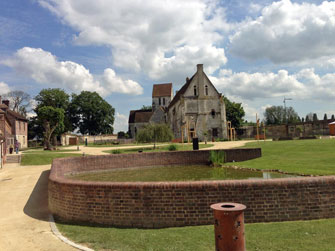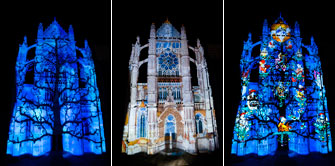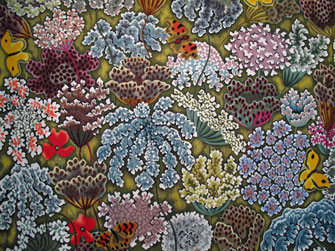A Destination,
Not an Airport

The Maladrerie Saint Lazare, where the lepers of Beauvais once lived. Photo: ParisUpdate.com
Every time I mention to friends that I have visited Beauvais, they laugh. This can be explained by the fact that many foreigners living in France think that Beauvais is just an unpleasant secondary airport over an hour away from Paris to which a certain low-cost airline buses its unhappy passengers hours before their flight time. Most of these budget travelers are blissfully (or, more likely, unhappily) unaware that Beauvais is actually an ancient city near the airport, built on Roman vestiges and famed as a historic center for royal tapestry making, for its cathedral and for a number of other attractions that it is now actively trying to bring to the attention of the rest of the world.
Beauvais has had its share of hard times. Its famous High Gothic Cathédrale Saint Pierre, for example, has often had trouble standing up. Part of the vaulting in the unfinished choir collapsed in 1284, and a few centuries later, in 1573, a central tower collapsed before it was finished. Perhaps discouraged by these disasters, the church never built the planned nave. The cathedral later suffered the indignity of having the statues chopped off its façade during the French Revolution. It survived the bombs that destroyed much of the city during World War II, but its stability is still in question.
Nonetheless, the natives are proud of their cathedral, which is not only the tallest medieval cathedral in France, but is also home to two fabulous clocks: one dating from the 14th century, the oldest clock in the world, which still works, and an enormous 19th-century astronomical clock featuring automats that tell the story of the Last Judgment. The cathedral also still has some stunning stained-glass windows from the 13th to 14th centuries.
This summer, the partially restored cathedral is being shown off in a new light with an inventive 30-minute son et lumière show, “La Cathédrale Infinie,” by the Skertzó agency, part

Three views of Skertzó’s illumination of the Beauvais Cathedral. © Yann Cochin, Ville de Beauvais
of which re-creates what the cathedral’s beautiful soaring facade might have looked like when the statues still graced it. Skertzó has also created a separate projection for the horizontal facade of the modern building of the tapestry museum, the Galerie Nationale de la Tapisserie par la Ville, located right next to the cathedral.
For its part, the tapestry museum, whose management was recently entrusted by the French government to the city of Beauvais, is currently holding a show of works by the Benedictine monk Dom Robert (1907-97), who was encouraged by renowned modern tapestry artist Jean Lurçat to apply his artistic talents to woven pieces. At their best, Dom Robert’s weavings offer a modern take on the great medieval millefleurs tapestries (a few of which

Detail of Dom Robert’s “Le Soleil pour Témoin” (1978). © Ville de Beauvais
are on show here), sharing the same themes and bursting with plants, flowers and animals in brilliant colors. A few of those on show, however, border on the kitsch. Interspersed among the tapestries are six contemporary works commissioned to respond to the monk’s tapestries, including an intriguing minimalist installation with dried weeds sprouting from slabs of marble by French artist Olivier Sévère.
If, while you are visiting Beauvais, you see various species of non-indigenous animals – a moose, a polar bear, a penguin, etc. – enthroned on wooden platforms, it is not because the city is a center of taxidermy. This is a commissioned installation, ”Les Hôtes du Logis,“ by Victoria Klotz, consisting of 12 hyperrealistic sculptures of animals.
Several of them are placed on the grounds of one of the city’s most fascinating sites, the Maladrerie Saint Lazare. This is the medieval complex where lepers were sent in the Middle Ages. Those suspected of having the disease were pronounced dead and, after a farewell mass, were subjected to a symbolic funeral: dirt was thrown on their heads to represent their burial. They were given a hut to live in a courtyard reserved for them, along with special clothes and noisemakers to warn people on the street of their approach, since they had the legal right to beg.
They were also allowed to live at the Maladrerie, where they had the not inconsiderable amenities for the poor in those days of a place to sleep and daily meals (some inmates were actually fakers looking for free room and board). People from all social classes were admitted and cared for by monks and nuns, as long as they were from Beauvais. The well-endowed Maladrerie was supported by donations from the wealthy seeking to curry favor with heaven.
Today the peaceful site, which can be visited, has a 12th-century church (in ruins), a lovely medieval garden and a restored 13th-century granary where concerts are held.
Tapestry-making continues today in Beauvais at the state-owned Manufacture de la Tapisserie, founded in 1664 by Louis XIV’s minister Colbert and now set in a red-brick complex that used to be a slaughterhouse, where traditional looms and techniques are still used to weave works designed by notable contemporary artists, some of which can take up to five years to make. They then become part of the collection of the Mobilier National, which provides furnishings to embassies, ministries and presidential residences. This fascinating workshop can be visited by arrangement with the local Tourism Office.
If, after all this, you still don’t appreciate Beauvais, you can always take a taxi to the airport and catch a flight to Rome. Or, better yet, if you are catching a flight to Rome or elsewhere in Europe, avoid the boredom of waiting in the airport by visiting the city before you board.
Cathédrale Saint-Pierre: Rue St-Pierre, 60000 Beauvais. Tel.: 03 44 48 11 60. Son et lumière: through September 14 on Thursday, Friday and Saturday in July and August, and Friday and Saturday in September, at 10:45pm through July 13; 10:30pm July 18-August 10; 10pm August 15-31; 9:15pm September 6-14. www.beauvais-cathedrale.fr
Galerie Nationale de la Tapisserie: 22, rue Saint-Pierre, 60000 Beauvais. Tel.: 03 44 15 67 00. Open Tuesday-Friday, noon-6pm, Saturday-Sunday, 10am-6pm. Admission: free. www.beauvais.fr
Office de Tourisme de l’Agglomération de Beauvais: 1 rue Beauregard, 60000 Beauvais. Tel.: 03 44 15 30 30. www.beauvaistourisme.fr
Maladrerie Saint-Lazare: 203, rue de Paris, 60000 Beauvais. Tel.: 03 44 15 67 61. www.maladrerie.fr
Click here to read all of this week’s new articles on the Paris Update home page.
Reader Michael Barker writes: “I would add that Beauvais was for long a center of ceramic-making which vibrantly and colourfully adorns many façades and floors of buildings in the region. It is worth looking at the former Maison Gréber, rue de Calais, of 1911 (now designated a Monument Historique) with its fantastical façade of little creatures in ceramic climbing up its face. And the museum (the former Bishop’s palace) contains striking Art Nouveau furniture.”
Reader Reaction: Click here to respond to this article (your response may be published on this page and is subject to editing).
Click here for more C’est Ironique! columns.
Support Paris Update by ordering books from Paris Update’s Amazon store at no extra cost. Click on your preferred Amazon location: U.K., France, U.S.
© 2013 Paris Update
Favorite